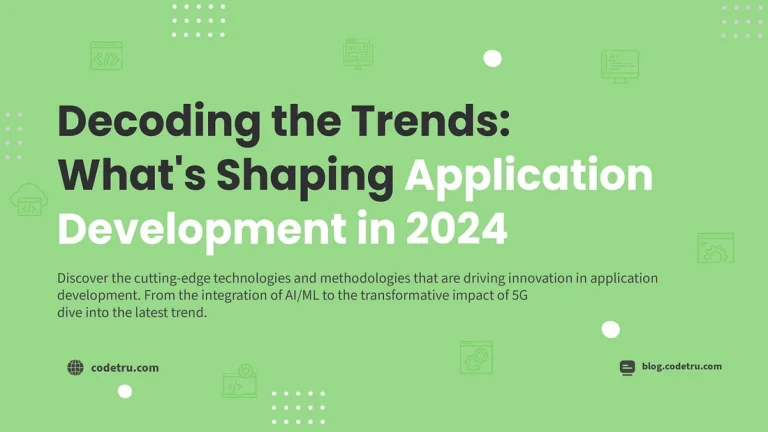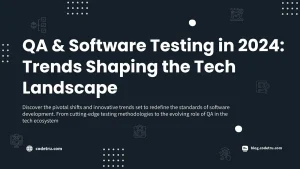The mobile app industry is always evolving, always changing presenting developers and businesses with new challenges and exciting opportunities.
This blog serves as your guide to understanding the intricate tapestry of mobile app development trends, exploring the innovations, methodologies, and strategies that will define the digital landscape ahead in the year.
In this blog post, we will take a deep dive into the complexities and highlight what’s driving the latest Mobile App Development trends in 2024.
Latest Mobile App Development Trends in 2024
Decentralized Apps (DApps)
One of the most prominent mobile app trend is the emergence of decentralized apps (DApps), which are applications that run on a distributed network of nodes, such as a blockchain or a peer-to-peer network.
In 2024, cloud computing has become an indispensable pillar in the realm of Decentralized Applications. Cloud computing services have evolved to seamlessly integrate with DApps, providing developers with scalable and reliable infrastructure solutions. This synergy between cloud computing and DApps not only enhances the scalability of blockchain networks but also facilitates the deployment and management of decentralized applications with greater efficiency.
With the popularity of decentralised apps on rise and the blockchain market projected to reach $52.5 billion by 2026, decentralised apps are the future of mobile app development spanning across various industries like retail, petroleum, telecommunication and manufacturing to name a few.
DApps offer several advantages over traditional apps, such as:
- Enhanced security and privacy: These do not rely on a central authority or intermediary to store, process, or transmit data.
- Increased transparency and trust: DApps use cryptographic protocols and smart contracts to ensure the validity and integrity of transactions and data.
- Greater scalability and performance: These mobile applications can leverage the collective computing power and bandwidth of the network, without being limited by a single server or provider.
5G Optimization
With the 5G technology on rise providing faster internet, another major app development trend is the optimization for 5G, the fifth generation of mobile network technology that promises to deliver unprecedented speed, bandwidth, latency, and reliability.
The 5G technology is going to take the mobile app development industry by storm with faster and more efficient transmission.
5G optimization requires application developers to consider various aspects, such as:
- Network slicing: Allows the creation of customized and isolated virtual networks for different applications and services, based on their specific requirements and preferences.
- Edge computing: Allows the processing and storage of data closer to the source and the user, reducing latency and bandwidth consumption, and improving security and privacy.
- Artificial Intelligence & Machine Learning: Enables the analysis and optimization of data and network performance, as well as the personalization and automation of user experiences and services.
AR-based Industry Applications
Augmented reality (AR) is a technology that overlays digital information and elements onto the physical world, enhancing the user’s perception and interaction with reality.
Apple launching Vision Pro in 2023, was just the tip of the iceberg. In 2024, with edge computing and 5G technology being the focal points, the integration of AR can be even more seamless and robust.
We can also expect to see AR apps used for everything from product visualization and education to maintenance and repair.
Some of the industries that have benefitted from the use of AR technology to provide solutions and services for various industrial sectors and domains, such as:
- Education, where can AR facilitates interactive and engaging learning experiences, as well as the visualization and simulation of complex concepts and phenomena. Google Expeditions allows teachers and students to explore virtual and augmented reality tours of various places, such as historical sites, natural wonders, and scientific processes.
- AR enables the planning, design, and execution of projects, as well as the inspection and maintenance of structures and facilities. Trimble provides AR solutions for various construction workflows, such as site layout, quality control, and collaboration.
- In retail, AR helps in the enhancement of shopping experiences, as well as the promotion and personalization of products and services. Ikea allows its customers to virtually place and preview furniture items in their homes.
- Industrial AR enables manufacturers to engage with their manufacturing plants in a most interactive way. It creates a digital twin and helps them identify anomalies that might affect production.
Improved IoT Connectivity
Another paramount mobile app trend that is advancing in 2024 is the integration of IoT in mobile apps. IoT is far from being a new concept, it has been around for over a decade. But with every device connected to the Internet, it’s time for IoT technologies to shine.
With IoT integration, mobile apps can control everything: from the thermostat in your home to the lights and security system, everything can be controlled remotely.
Improved IoT connectivity refers to the enhancement of the communication and integration of IoT devices and systems, using various technologies and standards, such as:
- Cellular IoT, which uses cellular networks, such as 4G, 5G, NB-IoT, and LTE-M, to provide reliable and secure connectivity for IoT devices, especially for wide-area and high-mobility applications. For example, Ericsson provides network optimization solutions for cellular IoT, using AI and ML, to improve network performance and user experience.
- WiFi, Bluetooth, and Zigbee, which use wireless protocols to provide short-range and low-power connectivity for IoT devices, especially for local-area and low-data applications. For example, Amazon Echo is a smart speaker that uses WiFi and Bluetooth to connect to various smart devices and services, such as lights, thermostats, and music streaming.
Increased Focus on Privacy and Security
Privacy and security are two essential aspects of application development, especially in the context of the increasing volume and variety of data and transactions that are generated and processed by applications.
Mobile apps are being used for everything, from storing important documents to signing important documents. With the introduction of mobile payments, the concern about privacy is even greater than before.
With users beings extremely concerned with their data privacy and security one of the main focus for developers should be making sure that their apps are secure.
According to latest reports, mobile and web apps focusing on data security and privacy such as Telegram, Firefox, Brave Browser etc are rising in popularity.
It insinuates the adoption of various measures and practices to protect the integrity of data and applications, such as:
- Data encryption, which uses cryptographic algorithms to transform data into unreadable formats, preventing unauthorized access and modification. For example, WhatsApp uses end-to-end encryption to ensure that only the sender and the receiver can read the messages and calls.
- Data anonymization, which uses techniques such as masking, hashing, and aggregation to remove or modify personally identifiable information (PII) from data, preserving the privacy of individuals.
- Data minimization, which uses principles such as purpose limitation, storage limitation, and data quality to collect and process only the necessary and relevant data, reducing the risks and costs of data breaches and misuse.
Health and Wellness Integration
Health and wellness are two interrelated aspects of human well-being, encompassing physical, mental, emotional, and social dimensions. Health and wellness integration refers to the incorporation of health and wellness features and services into applications, providing users with various benefits and values, such as:
- Health monitoring, which uses sensors, devices, and apps to measure and track various health indicators and parameters, such as heart rate, blood pressure, and sleep quality. For example, Fitbit monitors and records various health and fitness data, like steps, calories, and activity levels.
- Health promotion, which uses information, education, and motivation to encourage and support healthy behaviors and lifestyles including nutrition, exercise, and stress management.
- Health care, which uses telemedicine, telehealth, and digital health to provide access and delivery of health care services and resources, such as diagnosis, treatment, and prescription. For example, Teladoc18 is an app that connects users with licensed physicians and specialists, who can provide online consultations, diagnoses, and prescriptions.
Super Apps
A super app is a mobile or web app that provides a variety of seemingly unrelated services via a single user interface. Rather than having multiple apps for different services, a super app allows users to access and switch between various functions and features, such as communication, shopping, content consumption and provides a community for people.
Super apps offer several benefits for users and businesses such as:
- Convenience: users can access multiple services and functions with one app, without having to download, install, or switch between different apps.
- Cost-effectiveness: Users can save time, money, and data, by using one app that integrates various services and functions, and offers discounts, rewards, and incentives.
- Customer loyalty: People can enjoy a seamless and personalized user experience and build trust and relationship with the app and its partners.
- Cross-selling, as businesses can leverage the data and insights from the app and its users, to offer relevant and customized products and services, and increase revenue and profit.
Super apps are expected to grow and expand in the future, as they adapt to the changing needs and expectations of users and businesses, and leverage the emerging technologies and opportunities, such as 5G, AI, and blockchain. These in-demand apps are also likely to face various challenges and risks, such as regulation, competition, and security. Therefore, super app developers need to consider various factors and strategies, such as:
- User-centricity: Understanding and addressing the needs, preferences, and pain points of the target users, and providing a seamless and personalized user experience.
- Value proposition: Identifying and delivering the core value and benefit of the app and its services, and creating a unique and differentiated brand identity and positioning.
- Partnership: Collaborating and integrating with various partners and stakeholders, such as service providers, platform operators, and regulators, and creating a win-win and sustainable ecosystem.
- Innovation: Continuously improving and enhancing the app and its services, and exploring and experimenting with new technologies and opportunities.
Super apps are one of the rising mobile app development trends, as they provide users with a multifaceted and dynamic experience.
Conclusion
Mobile application development is a fast-paced and exciting field, that is constantly influenced by the changing needs and expectations of users, businesses, and society.
We have explored some of the key app development trends that are shaping the future in 2024 like decentralized apps, 5G optimization, AR-based industry applications, improved IoT connectivity, increased focus on privacy and security especially on social media, health and wellness integration in mobile devices, and super apps.
These mobile app trends represent the opportunities and challenges that application developers face, as they strive to create innovative and impactful solutions and services, that can enhance and transform the lives of millions of people around the world.
FAQs on Mobile App Development Trends in 2024
1. What are the major mobile app trends in 2024?
Key mobile app trends in 2024 include decentralized apps (DApps), 5G optimization, increasing augmented reality (AR) applications, advanced IoT connectivity, and increased focus on privacy and security. These trends are reshaping how developers create and enhance mobile applications.
2. How does 5G technology impact mobile app development?
5G technology significantly impacts mobile app development by providing faster internet speeds, lower latency and higher reliability. This enables developers to create applications that perform and consume more data, optimize network performance, and enhance user experience, especially for applications that require real-time data processing and delivery high-quality streaming.
3. What are the benefits of using AR in mobile app development?
Augmented reality (AR) in mobile application development offers many benefits, including enhanced user engagement, interactive learning experiences, and enhanced visualization of products and services. Industries such as education, retail, manufacturing and healthcare are using AR for immersive practical applications builds that improve user interaction and satisfaction.
4. Why is IoT connectivity important for mobile apps in 2024?
Enhancing IoT connectivity for mobile apps in 2024 is important because it enables seamless integration and communication between smart devices and systems. This connectivity enhances the functionality of mobile applications, allowing users to control and manage devices remotely, creating an efficient and automated environment in homes, businesses and cities
5. How can developers ensure privacy and security in mobile apps?
To ensure privacy and security in mobile apps, developers should implement robust data encryption, use data anonymization techniques, and follow data minimization principles. Additionally, staying updated with the latest security protocols and conducting regular security audits can help protect user data and maintain trust, especially with the increasing focus on privacy concerns in 2024.







